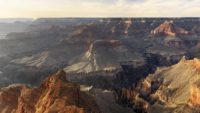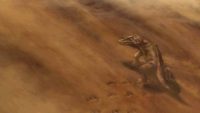By Dr. Terry Mortenson Examining the immense biblical data for Noah’s flood as an actual, year-long, worldwide, and catastrophic flood about 4,500 years ag …read more Source: AIG Daily
The preserved carcass of a “prehistoric” cave bear has been discovered in melting permafrost on an Arctic Russian Island.1,2 Reindeer herders discovered the remains of the adult cave bear on Bolshoy (or Great) Lyakhovsky Island, part of the New Siberian Islands off the coast of northern Russia.2 This is the first time that a whole bear carcass with preserved soft tissues has been discovered. Even the bear’s… More… …read more Source: icr.org
A new study published in Nature Communications claims to have figured out how the tectonic plates may have originated.1 It’s been over 50 years since the theory of plate tectonics became an accepted idea in the scientific community. But, secular scientists are still struggling to explain both the origin of the continental crust and the tectonic plates.2 Earth is unique in our solar system becaus… More… …read more Source: icr.org
By Troy Lacey Evolutionists tout the whale series as one of the best evidences foe evolution. However, there are lots of problems with the story of whale evolution. …read more Source: AIG Daily
A CMI supporter writes in with a comment about the assumptions made behind the method of carbon 14 dating. …read more Source: creation.com
New evidence the Greenland ice sheet is younger than previously thought …read more Source: creation.com
How Noah’s Flood formed this fascinating feature. …read more Source: creation.com
How does Earth’s atmosphere compare to those of other planets and what bearing does this question have for the creation versus evolution question? …read more Source: creation.com
Is the Hydroplate theory of Noah’s Flood the strongest Flood model on offer today? …read more Source: creation.com
Noah’s Flood explains Hopewell Rocks, Canada …read more Source: creation.com
By Dr. Steve Austin We should remember an important fact—creationist and evolutionist thinking about spillover continues to make a significant contribution to our understanding of erosion of Grand Canyon. …read more Source: AIG Daily
Was it by rafting or continental drift? …read more Source: creation.com
Is a dinosaur still a dinosaur if it has flight feathers? A new study points to some fascinating evidence that contradicts the idea of feathered dinosaurs and confirms created kinds. It’s no secret that birds fly in order to, among other reasons, get food and avoid becoming food. For that, they must have their feathers arranged in good order. But feathers wear out. If birds replaced their feathers haphazardly, for example, to… More… …read more Source: icr.org
It may not need tectonics or climate change. …read more Source: creation.com
A new way of looking at your world. …read more Source: creation.com
Exciting rock formations show that fossils form naturally much faster than we are conditioned to believe. …read more Source: creation.com
By Ken Ham Every year, hordes of tourists descend on Grand Canyon to enjoy the natural beauty of this geological wonder. But many tourists hiking the popular Bright Angel Trail missed something very interesting—a series of fossilized footprints preserved in a boulder, lying next to the trail, that had broken off a cliff in the nearby Manakacha Formation. But in 2016, a geology professor hiking with his students noticed the footprints, and now research on these tracks has been released. One of the scientists who studied these tracks, Stephen Rowland, shares: These are by far the oldest vertebrate tracks in [More]
Why it all depends on what is meant by ‘age’. …read more Source: creation.com
Ways they make conflicting results tell the same story. …read more Source: creation.com
These geological structures form much more quickly than was thought! …read more Source: creation.com
By Ken Ham Did small mammals scavenge dinosaur bones? A new study looked at tiny bite marks on the bones of massive long-necked dinosaurs, the sauropods, and concluded small scavenging mammals gnawed away at the bones. This makes sense within the context of the global flood. Eventually, rising floodwaters buried those remains, drowning and perhaps burying the scavengers along with them. As the floodwaters rose, dinosaurs and other creatures were drowned. Some were rapidly buried by the sediments carried in the water. Others drowned, and their decaying carcasses washed up on shore, where scavengers nibbled on a free meal. Eventually, [More]
By William Worraker The biblical and scientific arguments for a pre-Flood vapour canopy do not support the theory. …read more Source: AIG Daily
Are scientists always objective? Do they always interpret the evidence with an open mind? Some time ago I experienced first-hand how a scientist’s beliefs affect the way he looks at the evidence. Whilst a geology student at university, I needed to identify a fossil. After consulting the Atlas of Invertebrate Macrofossils 1 I had tentatively identified it as a belemnite2 of the genus Hibolites. However, paleontology was not my specialty so I sought advice from an expert. …read more Source: creation.com
A new study published in Nature Ecology & Evolution has claimed that flowering plants, the most common type of plant on Earth, first appeared in small numbers in rocks of the Early Cretaceous. Fossils indicate that these plants became extremely abundant in rocks of the post-Cretaceous (or Cenozoic) after the dinosaurs disappeared in the rock record.1 However, creation scientists interpret these findings much differently. W… More… …read more Source: icr.org
Vance Nelson’s latest book is impressive and like his previous works, contains a lot of original research accompanied with really beautiful pictures. A lot of time has gone into research and his photographic efforts. The book is written in an engaging and non-technical manner, and Vance took care to define his terms for lay readers. Summary: . …read more Source: creation.com
Evolutionary timeframes date the moon at about 4.5 billion years, with the lunar volcanism that produced the large, prominent and nearly circular, dark “seas” (or maria, as they are called) starting soon after that. The volcanism is mooted to have ended about three billion years ago. But researchers studying recent images of the far side of the moon, taken from the Japanese SELENE (Kaguya) lunar satellite, report dark “seas” of volcanic rock they say are “only” 2.5 billion years old, “much younger” than formerly presumed.1,2 That’s because there are fewer craters (blasted by meteors) on the smooth dark surfaces than [More]
The Salt Range of Pakistan has yielded some very interesting fossils-that according to evolution should not have been found! …read more Source: creation.com













































